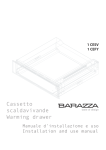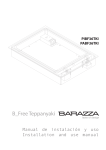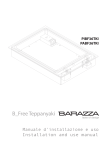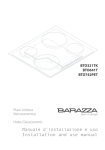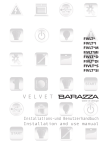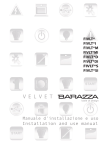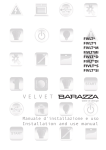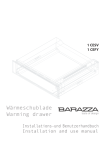Download CDA 4X7SS hob
Transcript
PISLG - inglese REV.06 INSTRUCTION FOR INSTALLATION AND USE HOBS SELECT SERIES built in flush WOLO SERIES STARK SERIES F.lli BARAZZA s.r.l. 31025 Sarano di Santa Lucia di Piave (TV) Via Risorgimento, 14 – Tel +39 0438 62888 Fax +39 0438 64901 www.barazzasrl.it E-mail: [email protected] DEAR CUSTOMER F.lli Barazza S.r.l. in present in the household appliances market for over 40 years. Now it would thank you to have bought its appliance and it want to assure you the quality of this product. The use of this appliance is not so difficult, but we would invite you, before starting use it, to read careful the instructions below. FOREWORD - This booklet accompanies the appliance and contains all the information you need to use and take care of it. - The user should read its instructions carefully and keep the booklet within reach. - The manufacturer shall not be held responsible for damage caused by improper use of the appliance, moving of the appliance with unsuitable means, unauthorized modifications and whatever else is not considered in this booklet. SAFETY - The appliance must be installed and connected to the mains by qualified personnel according to the norms in force and following the instructions in the chapter "Instructions for the installer", The use of protective glasses and gloves is recommended when unpacking and during maintenance, - This appliance has been designed and manufactured only to cook food. Never open it unduly or modify its characteristics and or use it for different purposes. - Please make sure that children do not touch the control panel or play with the appliance. The parts exposed during cooking warm up and will stay warm for a while after switching the appliance off. - After using the appliance make sure that the knobs are on the “off ” position. If the appliance is near other units make sure the cables are far enough from their hot parts. - Clean the appliance regularly. Residual food can cause risks of fire. - It is a good rule never to put food or containers in the oven when it is off. This would produce humidity and could cause accidents if switched on involuntarily - Should the appliance malfunction, authorized and competent personnel shall repair it to avoid any damage or incidents. Therefore please contact the after sales service. - The disposal of the appliance should follow the laws in force. This appliance is in compliance with the EEC requirement rules n. 89/336 on the electromagnetic compatibility and 73/23 on low tension and 90/396 on gas appliances. The instructions in this booklet are valid only for the country of destination, see symbol on the front page. 2 INSTRUCTION FOR THE USER Important: The appliance must be installed, regulated, connected to the gas network and electric mains, as well as adapted to the type of gas it will be fed with by qualified personnel, according to the norms in force and following the instructions in the second part of the instruction booklet. Metal utensils should not be left on top of cooker as they are prone to heat up and cause burns. HOB - Finding burners and description of control panel To find the knob that corresponds to the burner to use, refer to the silk screen printing on the control panel. 3 4 5 6 - How to use the burners Next to each knob there is a symbol that shows which burner it refers to. Each gas burner knob has the following symbols: Stop Maximum setting Minimum setting The burner should be turned on before putting the pan on the rung. To turn a burner on, press the knob right down turning it counter-clockwise to the maximum position and then press the electric ignition button. Let go of the knob after 5 seconds. If the burner fails to stay alight, keep the knob pressed right down longer to give the safety valve time to warm up. Check that the flame is regular and turn the knob to the setting required. If ignition is difficult or the flame irregular, check the correct position of the burner and its cover ( Fig.1 ). BURNER COVER BURNER NOZZLE HOLDER INTERCHANGEABLE NOZZLE Fig.1 To turn the flame out, turn the knob clockwise to the symbol. Before taking the pans off the rung, lower the flame or turn it out. If, when you’re using the hob, the flame goes out accidentally the safety valve will stop the flow of gas in about 40 seconds. 7 - Choosing the burners. For a better use of the burners you should use pans with diameters that match the size of the burners so as to have maximum efficiency using as little gas as possible. It is also essential when you are cooking to centre the pans on the burners and to use their lids. Burner Ø Pan in cm. Small auxiliary Medium semi fast Big fast Triple ring from from from from Ø6 Ø 15 Ø 20 Ø 24 to to to to Ø 18 Ø 22 Ø 28 Ø 32 As soon as the liquid in the pan starts to boil we advise turning the flame down just enough to keep the liquid boiling. It is important to remember that all the working positions must be selected between the maximum and minimum position, never between the maximum and stop position. DO NOT USE the burners without the pan supports supplied. Simmering aids such as asbestos or mesh mats are not recommended. They may impede burner performance, and damage the pan supports. Attention: This appliance must only be used for home cooking. When the appliance is working it can get very hot so keep children away. 8 INSTRUCTIONS FOR THE INSTALLER Installation must be performed by a qualified installer and conform to local codes, and carried out with extreme care. Prior to installation, ensure that the local distribution conditions (nature of gas and gas pressure) and the adjustments of the appliance are compatible. The gas adjustment conditions for this appliance are stated on the data plate located on the back of the appliance (see fig. 2) F.lli BARAZZA 0051 Questo apparecchio deve es sere installato conformemente alle norme in vigore e utiliz zato solamente in un locale ben areato. Consultare il libretto istruzioni prima di installare e usare l'appar ecchio. Fig. 2 Installation and adjustment must be done with maximum attention by qualified personnel and in accordance with current standards. If the appliance has to be adapted to a gas type different from the original one, enclosed with the guarantee you will find two labels for the installer to affix on the appliance’s rating plate and on the guarantee to make the new adjustment known. - Electrical connection Before connecting to the electricity mains first check that: - the electrical supply system is fitted with an effective earth connection; to the contrary it must be done separately and in compliance with current EEC standards; - The socket or four-pole connecting switch are easy to reach once the appliance is installed. The hob is supplied with lead on which a standardised plug must be fitted that will withstand the load indicated on the appliance’s rating plate; the plug must then be plugged into a suitable socket (Fig. 2). In all cases you must take the precaution to position the lead so that it will never exceed a temperature that is 50°C higher than environmental temperature in any one point. The manufacturer declines all responsibility if these accident prevention rules and regulations are not abided by. 9 - Connecting gas - Ensure that it has been adjusted to local fuel types. If it has not been adjusted, follow adjustment instructions as set out in ‘Adjustments for alternative gas types’. If it is to be fuelled by liquid gas, only a certified and approved pressure regulator is to be used. Connect the appliance to gas cylinder or other gas supply in accordance with local codes and regulations. - Connecting appliance - The hob can be installed with either an approved stainless steel flexible pipe or a rigid pipe. Connection is made to the GJ1/2” threaded elbow. The gasket has to guarantee the connection holds fast. The elbow can be turned by releasing the nut. Once the desired position has been established it is to be tightened again. Shaft pipe Nut Gasket Fitting for metal pipe Fig. 3 Important: After the installation check there are no leaks by using a soap solution and never a flame. The manufactured declines every responsibility if these safety standards are not respected. 10 TECHNICAL FEATURES Dimensions: FITTED HOBS width depth SELECT size 30 module size 60 module size 70 module size 90 module size 100 module size 120 module size Corner module cm. 30 cm. 58.5 cm. 70 cm. 86 cm. 100 cm. 116 cm. 83 cm. 50 cm. 50 cm. 50 cm. 50 cm. 45 cm. 35 cm. 83 WOLO size 60 module cm. 58.5 cm. 51 STARK size 70 module cm. 71.5 cm. 51 Electrical components: Electronic ignition V.A. 0,6 Isolation category I Supply voltage 230V 50 Hz N.B.: On the professional hobs, the depth can vary as well as the length. 11 MAINTAINANCE AND CLEANING - Cleaning the hob Before you start cleaning the hob wait until the rungs, burners and hotplates are cold and then, for greater safety, turn the power off via the main switch. Wash the enamelled, painted or chromium parts with warm water and soap or a mild, non-corrosive liquid detergent, avoiding all abrasive substances. Do not leave acid or alkaline substances (lemon juice, vinegar, etc.) on for any length of time as they can ruin the surface. If your hob is in stainless steel, use a damp cloth and a suitable, non-abrasive product, easily found on the market, or hot vinegar. Dry with a soft cloth or chamois leather. NB: Do not steam clean. - Cleaning the gas burners Once the components are cold take the burners off and wash them with hot water and a liquid detergent. Dry them thoroughly before putting them back, checking that no openings are clogged with dirt. The burners must be put back properly otherwise it could lead to serious combustion anomalies. The nozzle holders, Fig. 4, also need cleaning periodically, removing any dirt that may have accumulated and suctioning them, also checking that the gas outlet holes are not clogged. PAN BURNER COVER BURNER NOZZLE HOLDER Fig. 4 WARNING: Keep the openings on the triple burner clean. To do this, use a piece of cotton wool soaked in a mild non-abrasive and non-corrosive detergent 12 - Repairs on electrical parts Before calling the Technical Assistance Service check that: - The plug has not come out of the socket. The main switch in the home is on. If necessary, have the appliance serviced by qualified personnel. Remove the plug from socket before disassembling any part. - Replacement of feed cable The feed cable must be in HO5 RR-F, with a cross sectional area of 3x1 mm². It can be replaced as follows: - open the terminal board; connect the wires to their terminals: N – L – Earth; secure the wire with the cable clamp; close the terminal board with screws; Fig. 5 N.B.: After installation the lead must be accessible. - Adapting hob burners to other types of gases These hob models are fitted with burners that require no air regulation. For this reason, to adapt the appliance to work with a gas different to what it has been set for, simply substitute the nozzles and adjust the minimum. 13 a) Changing the nozzles Remove the rungs, burners and flame dividers. Using the spanner provided with the appliance, remove the nozzles – Fig. 6 and replace them with those enclosed, strictly observing the marking and the following table. NOZZLE HOLDER INTERCHANGEABLE NOZZLE Fig. 6 If the appliance has to be adjusted to suit a different gas source, the installer has to fix the new labels over the old ones. Two labels are found in the guarantee and in the back of appliance. NOZZLE TABLE Small auxiliary burner Medium semi fast burner Big fast burner Triple ring burner 3.8 kW Liquid G30 Liquid G31 Liquid G30 Liquid G31 Natural G20 Natural G25 Liquid G30 Liquid G31 Liquid G30 Liquid G31 Natural G20 Natural G25 Liquid G30 Liquid G31 Liquid G30 Liquid G31 Natural G20 Natural G25 Liquid G30 Liquid G31 Liquid G30 Liquid G31 Natural G20 Natural G25 30 mbar 37 mbar 50 mbar 50 mbar 20 mbar 25 mbar 30 mbar 37 mbar 50 mbar 50 mbar 20 mbar 25 mbar 30 mbar 37 mbar 50 mbar 50 mbar 20 mbar 25 mbar 30 mbar 37 mbar 50 mbar 50 mbar 20 mbar 25 mbar g/h 73 g/h 90 g/h 121 g/h 121 l/h 94 l/h 110 g/h 127 g/h 157 g/h 212 g/h 212 l/h 158 l/h 165 g/h 218 g/h 269 g/h 363 g/h 363 l/h 270 l/h 292 g/h 276 g/h 340 g/h 460 g/h 460 l/h 358 l/h 411 14 50 50 43 43 71 72 65 65 58 58 96 94 85 85 75 75 115 121 98 98 77 77 133 140 kW 1 kW 1 kW 1 kW 1 kW 1 kW 1 kW 1.75 kW 1.75 kW 1.75 kW 1.75 kW 1.75 kW 1.75 kW 3 kW 3 kW 3 kW 3 kW 3 kW 3 kW 3.8 kW 3.8 kW 3.8 kW 3.8 kW 3.8 kW 3.8 kW 0.45 kW 0.45 kW 0.45 kW 0.45 kW 0.45 kW 0.45 kW 0.45 kW 0.45 kW 0.45 kW 0.45 kW 0.45 kW 0.45 kW 0.85 kW 0.85 kW 0.85 kW 0.85 kW 0.85 kW 0.85 kW 1.40 kW 1.40 kW 1.40 kW 1.40 kW 1.40 kW 1.40 b) Regulating the minimum To adjust the hob burner minimum, light the burners and turn them down to minimum (serigraphed small flame). Take the knob off (it simply pulls off) and insert the screwdriver (provided with the appliance) in the screw in the knob holder pin (Fig.7): turn this screw to the right to make the flame smaller or to the left to make it bigger until you reach the minimum wanted. If the appliance is working on liquid gas (G30/G31), the minimum adjustment screw must be screwed down completely. After these conversions and adjustments use soapy water to check for gas leaks and make sure the burners and working properly. Turn quickly the knob from maximum to minimum, the flame mustn’t extinguish, in case it comes, adjust the minimum again. Fig. 7 Attention: Check the condition of the flexible gas pipe periodically and change it whenever you notice it is deteriorating. It is advisable to check it at least once a year. It must only be changed by qualified personnel. WARNINGS: - If the burner flame goes out accidentally, close the knob and do not attempt to light it again for at least 1 minute. - When gas cooking appliances are used they produce heat and humidity in the room in which they are installed. Please ensure good aeration in the room keeping the natural ventilation vents free and open or install a suction hood with discharge duct. - An intensive and prolonged use of the appliance might need additional aeration like, for instance, the opening of a window or a more effective aeration, increasing mechanical suction power if it exists. 15 - Lubricating the cocks periodically This must be done by qualified personnel whom you must contact also if the appliance is malfunctioning. It is however advisable each time work is done on the cocks, to change the cocks and gasket. - Knobs - The gas hob burner knobs are ONLY TO BE REMOVED for servicing (regulating the minimum flame) and NOT for cleaning. They are to be replaced in the correct order and in their original position. Any changes will result in the appliance malfunctioning. PROBLEMS AND SUGGESTIONS Problem Suggestions The gas flow seem irregular - Check that the gas cock is open. - Clean the holes of the flame breaker and the nozzle. - Check the position of the burner. Smell of gas in the room - Check the knobs are in the OFF position - Check the condition of the feeding pipe and its connections. The pilot light of the electric hotplate or griddle is not working - Make sure the lead is connected to the mains. If the problems persist or cannot be remedied with the above suggestions, contact the nearest Assistance Centre explaining the problem found, the model, the item and serial number of the appliance written on the guarantee certificate. 16 ATTENTION This appliances can be installed and used only on permanently ventilated premises in accordance with the standards. - Installation premises To ensure the gas-run appliance works properly the room in which it is installed must have enough air for the combustion gas, in compliance with the current standards. Vents with a minimum section of at least 100 cm², must be made so they cannot be obstructed either from indoors or outdoors and located close to the floor Fig.9; any other type of ventilation must necessarily comply with the contents of the standard. - Fumes discharge Gas-run appliances must discharge the products of combustion directly outdoors through a flue, suction hood or electric at a flow rate that will guarantee an hourly change of air that is at least 3 times the volume of the room. Remember that the 3 air necessary for combustion is 2m /h for each kW of nominal heat capacity (see rating plate). ELETRIC FAN HEIGHT = 70 cm MIN. AIR INLET 100 cm² MIN. 17 HEIGHT = 56 cm DISTANCE FROM THE SIDE = RIF.A DISTANCE FROM THE BACK = RIF.B Fig. 9 RIF.A RIF.B 30 module 80 mm 50 mm 60 module 20 mm 50 mm 70 module 100 mm 50 mm 90 module 20 mm 50 mm 100 module 100 mm 50 mm 116 module 20 mm 50 mm Corner module 50 mm 50 mm 18 FITTING A HOB INTO A MODULAR UNIT The hobs can be mounted on all units in wood, laminated plastic, metal and granite provided they are heat resistant (120°C). The appliances are classified type y, therefore, if there is a side wall it can be higher than the hob. Fitted hobs are class 3; 100 min These appliances can also be fitted on top of an oven. If the hob is fitted on top of an oven a separating panel must be used, putting it on top of the oven, at a distance from the undercounter of at least 100 mm. It can be perforated at the back only to let the hob’s gas pipe and electricity lead through. 585 Undercounting separating panel with holes for the gas pipe and lead hole 40 x 400 mm 56 0 Fig. 10 The dimensional characteristics of the hobs, their housing holes and of the undercounter units are given in the following drawings. 19 SIZES OF THE FITTED AND SUPPORTED HOBS AND HOUSING HOLES Measurements in mm. Select 30 module – built in Select 60 module – built in 0 29 5 58 50 0 48 0 3 45 45 3 50 0 48 0 0 27 70 Select 90 module – built in 27 Select 70 module – built in 0 56 0 0 50 0 45 3 55 3 50 0 18 0 86 48 0 0 68 48 0 20 0 84 Select 120 module – built in 27 Select 100 module – built in 11 18 35 0 3 45 45 0 0 98 43 0 3 30 Select 90 corner module – built in 0 83 45 10 50 0 20 60 5 5 48 60 3 00 10 0 33 0 81 0 21 40 11 Select 70 module – flush Select 90 module – flush R 0 55 674 0 0 83 50 0 R 26.5 4 50 80 3 R 26.5 0 68 03 7 0 84 63 8 4 50 80 3 Lowering belt h=1.7 mm Lowering belt h=1.7 mm Select 100 module – flush Select 120 module – flush 00 10 R 0 85 97 0 18 60 11 20 11 35 0 R 26.5 4 45 30 3 25 98 46.5 45 0 25 28.5 R 25 46.5 86 18 0 70 50 0 25 28.5 R R 26.5 0 03 10 33 0 35 3 40 1 1 163 1 Lowering belt h=1.7 mm Lowering belt h=1.7 mm 22 Wolo 60 module – built in 0 8 5 71 51 0 48 0 43 41 51 5 11 58 Stark 70 module – built in 56 48 0 0 0 68 ASSEMBLY DIAGRAM FOR FITTED HOBS The hobs are provided with brackets so they can be fixed on any type of top, as per the following diagram: Silicone Silicone Piano Silicone Top Hob Piano Hob 10 10 1,7 30 / 40 1,5 30 / 40 3 Top Staffa Staffa Bracket Bracket Vite Vite Screw Screw Fig. 11 23 ATTENTION This appliance has to be disposed off in accordance with local rules and regulations regarding. For Europe 2002/96/CE and 2003/108/CE 24
























